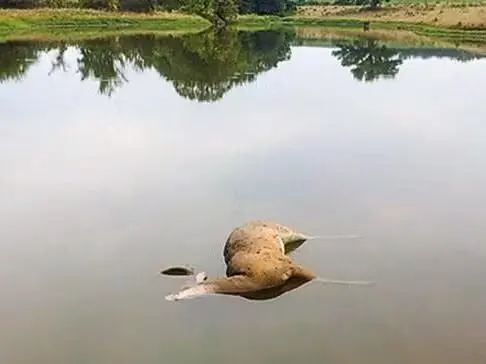
The disease is spread through the bite of a native midge. Outbreaks usually happen July into October and reporting helps MDC track cases.
JEFFERSON CITY, Mo. – The Missouri Department of Conservation (MDC) is receiving reports of hemorrhagic disease (HD) in Missouri deer this summer and is asking the public to help determine the extent of the disease by reporting suspected cases.
HD is a general term for two related viruses: epizootic hemorrhagic disease and bluetongue. They are spread to deer through the bite of a tiny, native midge, often called a “no-see-um” or “gnat.”
While MDC does not anticipate a large outbreak this year, every report helps biologists monitor deer health and better understand the impacts of the disease.
“Hemorrhagic disease is a naturally occurring virus in Missouri’s deer population,” explained MDC Wildlife Health Program Supervisor Deb Hudman. “Outbreaks are most common between July and October and typically end after a heavy frost kills the midges that spread it.”
Signs of HD in deer can include reluctance to move; difficulty breathing; swelling of the head, neck, or tongue; and unusual behavior such as appearing dazed or unresponsive. The virus can cause high fever, prompting infected deer to seek water. Deer that die from HD are often found in or near water. Death can occur within days of infection, though some deer survive and develop immunity. There is no cure or vaccine for HD.
HD kills deer quickly, making the effects of the disease highly visible. However, the disease does not have long-term effects on the overall health or sustainability of Missouri deer numbers. Even after a severe outbreak, the deer population recovers within a few years.
“We care deeply about Missouri deer and deer hunting,” Hudman said. “By reporting suspected cases of HD, members of the public can help us track where the disease is occurring and how it’s affecting deer numbers in specific areas.”
Missouri’s most severe HD outbreak occurred in 2012 during an extreme drought when deer gathered around limited water sources, increasing their exposure to infected midges.
Learn more about hemorrhagic disease at mdc.mo.gov/wildlife/wildlife-diseases/hemorrhagic-disease.
To report a suspected case of HD, contact the local MDC office or speak with a conservation agent. Find local MDC offices and agents online at mdc.mo.gov/contact-engage/local-mdc-contacts.
People can also report suspected cases online through MDC’s Wildlife Health Event Reporting Application at mdc12.mdc.mo.gov/applications/WildlifeHealthReporting.










